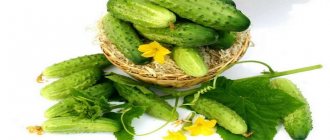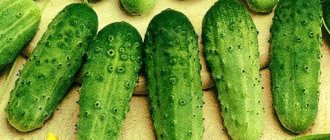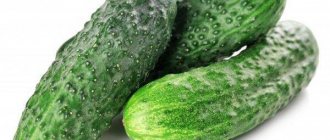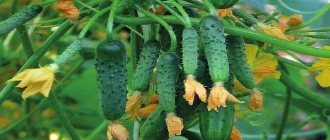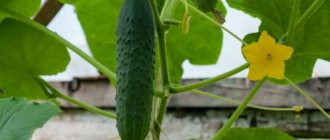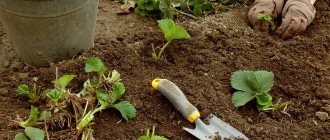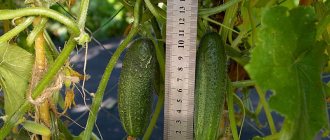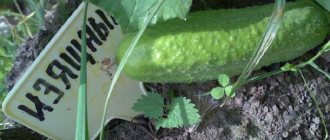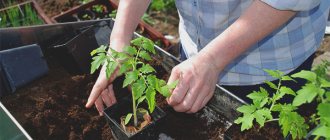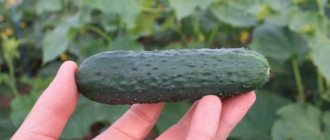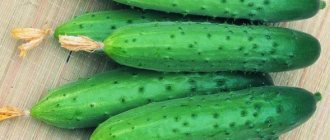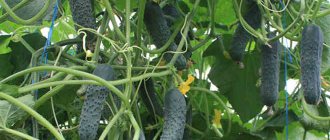This is an excellent hybrid for cultivation in small garden plots and large farmlands. Monolith F1, due to its productivity and marketability, is used for commercial sales and mass processing in canneries.
| Landing location | Ripening time | Mode of application | Fruit length | Group | Fruit smoothness | Pollination method |
| Universal | Early ripening (35-45 days) | Universal | Medium - from 10 to 15 cm | Hybrid | Highly lumpy | Parthenocarpic |
Description of Monolith cucumbers
Monolith f1 cucumbers are an excellent hybrid that is famous among vegetable growers for its high yield level, long fruiting period, excellent presentation and taste characteristics. It is recommended to grow hybrid Monolith cucumbers in such regions of the Russian Federation as Astrakhan, Volgograd region, Saratov and Kalmykia.
In terms of ripening time, the variety belongs to the ultra-early varieties, since the first fruits appear 35-40 days after the plant sprouts appear.
Monolith f1 cucumbers are versatile in use. The fruits of the variety are suitable not only for fresh preparation. Gherkins are also used for preservation and pickling. In addition, when preserved, cucumbers do not lose their density, elasticity and crispness.
Variety characteristics:
- Cucumber bushes are of the indeterminate type and reach a height of up to 3 m;
- Description of flowering type: female inflorescences of bright yellow color predominate;
- The root system of cucumbers is superficial, reaches 50 cm;
- Description of the ovaries: about 3 ovaries can form in 1 node;
- Cucumbers have a cylindrical shape up to 15 cm long;
- The peel of cucumbers is covered with small, frequent tubercles and has a rich green color;
- The fruit pulp is juicy, crisp, without voids;
- Description of taste characteristics: sweet, not bitter.
Cucumber Monolith F1: variety description, agricultural technology, reviews, photos
Monolith cucumbers are a plant of continuous growth. The culture has an average height. Without pinching and correction, the lashes can reach 3 m. The number of lateral processes is insignificant. In one season you can harvest three times.
The variety allows you to produce pickles and gherkins. Monolit cucumbers were added to the State Register of the Russian Federation in 2013. Recommended for breeding in the Lower Volga region. The originator and supplier of seeds is Dutch.
The hybrid is adapted for cultivation in open ground.
The monolith is characterized by a strong and powerful main stem. Its surface is ribbed, with the presence of small, prickly fibers. The side shoots are thinner than the central stem. The color of the vegetative part is light green.
The number of leaves of cucumbers of the Monolith variety is small. The leaf blade is supported by a long petiole, shaped like a heart, with wavy edges. The leaf has visible veins that are lighter than the main tone. The leaf has a prickly hairiness.
Inflorescences are formed at the preleaf node. The flowering process is abundant. The flowers are predominantly female. There are a lot of ovaries on the bush. The flowers are rich yellow in color, collected in inflorescences of 3 pieces.
In the photo, Monolith cucumbers have an elongated shape, which is also indicated in the description. Size up to 12 cm in length. The color of the vegetable is dark green, with white stripes evenly distributed over the surface. Weight 100 g.
The surface of the hybrid is finely lumpy, spiny, and glossy. The skin is thin and hard. The pulp is juicy. The flavors are balanced: there is no bitter aftertaste or acid, but there is a light cucumber aroma.
The fruits of cucumbers of the Monolith variety are suitable for processing in the food industry, as well as for various kinds of preparations. After heat treatment, the skin does not lose its appearance, its shape is maintained, and voids do not form inside the cucumber. The Monolith cucumber variety is suitable for fresh consumption.
Important! The hybrid variety of cucumbers Monolith does not contain genetically modified elements, so there are no restrictions on consumption.
When choosing a vegetable crop, the gardener should read the description of Monolith F1 cucumbers, as well as reviews from those who have already tried them. Based on the information received, the strengths and weaknesses of the plant were determined.
Advantages of the variety:
- stable fruiting;
- resistance to sudden temperature changes;
- possibility of storage for a week;
- high transportability;
- maintaining the presentation and weight of the fruit;
- the skin is thin, tender;
- lack of bitter taste;
- good immunity.
The disadvantages of Monolith cucumbers include the inability to collect seeds. Planting material of hybrid varieties, as a rule, does not germinate or does not give the desired result. The qualities of the mother plant are not preserved.
To reduce the ripening time of vegetables, it is recommended to use the seedling method. So, seedlings can be planted in beds within three weeks after sowing.
The main feature of the Monolith cucumber variety is the ability to plant vegetables several times per season. First, one batch of seeds is sown, and after 14 days, the second. When the first bushes have stopped bearing fruit, they are removed, and new seedlings are placed in this place.
You need to choose the right substrate before transplanting seedlings. Because plants react poorly to acidity levels. To neutralize the composition of the soil, lime or dolomite flour is added to it in the fall. In spring the soil will have the required pH
Important
Experienced gardeners in reviews recommend choosing exclusively sunny areas for cucumbers of the Monolith variety. Then the taste will be higher. Trellis are installed next to the bushes. The tension of the entire growing season of the lash is fixed to the supports.
Agrotechnical measures for cucumbers of the Monolith variety include:
- Plants tolerate heat well provided they are watered regularly. It is enough to moisturize once every 2 days and only with warm water. The procedure should be performed in the evening.
- Loosening is carried out when a crust forms on the soil surface.
- As the weeds grow, it is necessary to weed the beds with Monolith cucumbers. Tall grass creates unwanted shade and draws beneficial microelements from the soil.
- It is recommended to fertilize Monolith cucumber bushes with complex preparations, following the recommendations for use. You can also use organic fertilizers.
- It is recommended to form a bush with one stem, remove side shoots and dry lower leaves. Pinch the top at trellis level.
Attention! In general, the number of feedings of Monolith cucumbers should not be more than five for the entire season.
Productivity
Monolith considers the cucumber variety to be ultra-early. From the appearance of the first green shoots to the fruits, a little more than a month passes, about 35-40 days. Already in May they reach biological maturity. The advantage of this hybrid is its productivity. The flowers are formed as female ones, their falling off is not noticed. Thus, all the ovaries ripen, delighting gardeners.
In addition, the fruiting of Monolith cucumbers is not affected by sudden changes in temperature or the presence of sun. The plant is characterized by frost resistance and shade tolerance.
The average yield from a vegetable crop is 10 kg. If you observe the frequency of planting, you can harvest 3 times per season.
Important! Monolith cucumbers require regular watering. In drought conditions they will not bear fruit.
Conclusion
Monolith cucumbers are an ultra-early hybrid. The variety is suitable for growing in open ground. The plant is resistant to diseases and pests. Easily tolerates heat and temperature changes. The fruits have a universal purpose.
Yulia Nikolaevna, 39 years old, Ulyanovsk, I plant cucumbers every year at my summer cottage. I tried many varieties. Typically, early fruits do not have a pronounced aroma; they have watery pulp. The monolith made me happy. The taste is excellent, the harvest is good. All cucumbers are perfect, hard, with pimples. Standard care is required.
When the first 4 leaves appeared, I fed it with mullein. Subsequently, I watered it once every 2-3 days. In general, I was pleased with the variety. Next year I will plant more, only more. Marina Anatolyevna, 44 years old, Tver Two years ago we tried the Monolith cucumber variety. I planted seedlings in the beds around May.
However, the spring was long, there were frosts at night, and the leaves froze. At first they wanted to tear them out, but they left them and not in vain. The bushes moved away and quickly began to grow. As a result, we collected about 8 kg from each plant. Small fruits were picked for preservation. The pulp is not bitter at all, so I recommend it to everyone.
Pros and cons of the variety
The hybrid variety Monolith has a list of advantages, thanks to which the variety is popular among vegetable growers who grow crops on an industrial scale. Let's look at the description of the advantages.
pros
- High level of productivity of the variety;
- Long-term fruiting;
- Cucumbers have the same shape and weight;
- Resistance of the variety to various crop diseases;
- Versatility in the use of the variety;
- Excellent taste characteristics of Monolith cucumbers;
- Resistance to climatic conditions, temperature changes;
- Excellent presentation and keeping quality;
- Variety resistance to transportation.
Minuses
The breeders who developed the Monolith variety are convinced that cucumbers have no drawbacks. However, experience in growing cucumbers has shown that there is still one drawback: cucumbers do not have seed material that is suitable for subsequent plantings.
Advantages and disadvantages
Pros:
- long-term storage without loss of commercial properties (7 days at 4 degrees and 80% humidity);
- versatility of use;
- balanced taste with a fresh aroma;
- good transportation;
- stress resistance;
- tolerance of temperature drops within 7-8 degrees;
- resistance to return frosts (complete restoration of affected areas in 5-7 days).
Minuses:
- inability to collect your own seed material.
Landing Features
It is recommended to plant Monolith cucumbers in open soil. Planting is carried out in two ways: sowing (seeds are sown in open soil), or seedlings (ready-made sprouts are planted in open ground). It is worth noting that all early ripening varieties are recommended to be planted using seedlings. Let's look at the description of recommendations for planting the Monolith variety.
Landing dates
To obtain seedlings, seed is sown at the end of March. The next planting processes are carried out after 2 weeks.
If Monolith f1 seeds are sown immediately in open soil, the procedure is performed in the first half of June.
The peculiarity of the hybrid variety is that it can be planted several times: in the spring, seedlings of different sowing times can be planted. The time between sowings reaches 10 days. Afterwards, the first bushes are removed and the next seeds are planted.
Site preparation
Before you begin preparing the land, you need to pay attention to the soil. Monolith f1 cucumbers are not recommended for planting in acidic soils. Sandy or loamy soils are more suitable for growing the variety.
Beds with cucumbers should be located in a well-lit area without draft winds. If the variety is grown in small areas, for example, in a vegetable garden, the beds are located near the southern wall of the building.
It is recommended to prepare an area for cucumbers in the autumn: carefully dig up the ground and remove all unwanted plants. The soil is fed with compost and lime is also added. In the autumn, before planting Monolith f1 cucumbers, the soil is loosened and fed with ammonium nitrate.
Planting seeds
Before sowing Monolith cucumber seeds, they must be placed in a damp cloth and sent to a cold place for 24 hours. A day later, the seeds are placed in a manganese solution for 30 minutes for processing.
Seedlings are usually grown in peat pots or disposable glasses. Seeds are placed in pre-fertilized soil up to 3 cm deep.
In order for the bushes of the Monolith variety to develop well, the future seedlings are removed to a well-lit, warm place. It is advisable that containers with seed material be exposed to light for at least 16 hours a day.
Planting seedlings
Monolith seedlings are planted in open soil at the moment when about 5 leaves have formed on the bushes, and the soil temperature reaches 13 degrees Celsius.
Monolith cucumbers are planted together with a lump of earth located on the roots of the bushes in a hole up to 10 cm deep (up to the bottom leaf). It is important to ensure that the roots are not disturbed, as the plant will begin to hurt or die altogether.
After planting, the plant is watered and the root area is sprinkled with wood ash.
Planting scheme
The Monolith f1 variety must be planted at a distance of 35 cm between bushes and 45 cm between beds. Thus, there are 3-4 bushes per 1 m2.
Features of agricultural technology from the manufacturer
It is better to grow Monolith cucumber with seedlings. The young plant will be ready to be transferred to a permanent bed by the 22nd day from the moment of germination. A minimum of 3 leaves is required. For the first time in OG, seedlings will need film protection.
Advice. Place on 1 square. m no more than 3 varieties of bushes.
Sowing seeds for seedlings | Planting seedlings in a greenhouse | Planting seedlings in exhaust gas | Stepsoning | Harvesting (in the greenhouse / in the greenhouse) |
| Late April-early May | Second half of May | The beginning of June | Blinding of the first 3-4 nodes | Second half of June/early July |
| *dates are indicated for spring-summer turnover in the middle zone climate | ||||
Care
Monolith cucumbers, like the Emerald Family, require regular watering, fertilizing and hilling the bushes, as well as tying and shaping the stems. Below is a description of proper care for the variety.
Watering
The yield level of the variety directly depends on irrigation work. In order for cucumbers to be juicy and sweet, and also to withstand heat well, the plant must be watered regularly.
Watering work is recommended to be carried out daily early in the morning or in the evening when the sun sets. It is advisable to water the bushes at the root so that the leaves of the plant do not turn yellow and begin to rot. 1 bush of the variety requires about 4 liters of water.
The water temperature should match the soil temperature. To do this, the liquid is infused in the sun's rays, or heated independently.
Garter and bush formation
Before planting Monolith bushes, it is necessary to install a trellis, to which the plants will then be tied. The formation of a bush is carried out in 1 stem trellis height. If the bush is too tall, its top must be broken. It is also recommended to remove all side loops and cut off the bottom dry leaves.
Tying and forming a bush with cucumbers is carried out throughout the entire growing season of the variety.
If you do not follow the rules for forming bushes, the shape of the fruit may be disrupted, resulting in twisted cucumbers.
Top dressing
Over the entire growing season, Monolith f1 cucumbers need 4-5 feedings. It is recommended to water the plant with various minerals (superphosphate, ammophos, urea) and organic matter. Also used for feeding are the preparations “Dobrivo”, “Master”, “Agricola” and “Komplemet”.
Hilling
It is not recommended to hill up cucumbers, since the root system of the vegetable is located along the earth's surface, therefore, as a result of hilling, you can catch the root and harm it.
However, vegetable growers strongly recommend loosening the soil with a pitchfork after watering. This method allows you to remove the stagnant top layer of soil and pass the necessary amount of oxygen to the root system of cucumbers, as well as get rid of weeds.
Growing and care
Agricultural technology activities are not difficult:
- shaping into 1 trunk, pinching at trellis level or tucking;
- removing dried and yellowed leaves;
- trimming side lashes;
- moderate watering (3-4 liters of water per plant) in the evening;
- loosening after watering to avoid crusting;
- removal of weeds (serve as a place where pests and pathogens hide);
- installation of vertical structures and garter.
Feeding is carried out 4-5 times per season. Alternate watering with organic matter and minerals. Of the mineral compositions used:
- Nitroammophoska;
- Ammophos;
- Urea;
- Superphosphate.
Complex mixtures – Dobrivo, Agricola, Master, Komplemet – increase productivity.
Diseases and parasites
Despite the strong immunity of the Monolit f1 variety to many cucumber diseases, cucumbers are still susceptible to infections such as downy mildew, BOM-1, and anthracnose. Let's consider a description of each disease and methods of combating them.
Downy mildew
Downy mildew, or downy mildew, is a disease of cucumbers that occurs as a result of high atmospheric pressure, high humidity, and dense plantings.
With downy mildew, the following symptoms are observed: the leaves of the plant become covered with small yellow spots, which soon acquire an oily composition. Also, a gray coating with purple hues forms on the leaves, and the spots become larger and take on a brown color. The leaves of the plant begin to curl, dry out and fall off.
To combat peronosporosis, it is recommended to use the chemical preparations “Previkur”, “Ordan”, “Kurzat”, “Abiga-Pik”, as well as “Oksikhom” and “Signum”.
PTO-1
VOM-1 or common mosaic is a viral disease in which the formation of light green spots on the surface of the leaves is observed. In addition, small swellings begin to form on the leaves, which lead to its corrugation. Also, spots and swellings form on the cucumbers themselves.
To combat VOM-1, the chemical drug “Farmayoda” and the biological agents “Aktelikt” and “Aktara” are used.
Anthracnose
Anthracnose is a fungal infection that can cause damage to the entire bush and its fruits. The second name of the disease is copperhead. With anthracnose, the formation of depressed brown spots is observed that form on the root collar of the plant.
Small spots of a pale green hue form on the leaves of cucumbers, which soon turn brown. At the same time, the leaf begins to dry out and break. With high humidity, rotting of the leaves is observed. Oval-shaped depressed spots that are light brown in color also appear on cucumbers. With anthracnose, cucumbers begin to taste bitter, darken and rot.
To combat anthracnose, it is recommended to use the chemicals Previkur, Quadris, Fundazol and Fitosporin.
Dutch varieties of cucumbers: description of the best types with photos
At the beginning of the sowing season, gardeners are faced with the pressing question of what planting material to choose this year. Increasingly, our summer residents are choosing Dutch varieties of cucumbers, which were bred by breeders for cultivation in different climatic conditions.
The choice of seeds on the market is varied - some are resistant to temperature changes, others have high yields, and others receive positive reviews due to their unique taste.
As a rule, the Dutch produce cucumber hybrids labeled f1 - they cross two varieties into one to produce high-quality seeds that are disease-resistant and have excellent taste. But, unfortunately, the hybrid is not capable of producing a harvest the next year, so the seeds will have to be purchased again.
Most of the planting material is self-pollinating, which makes it possible to grow cucumbers of Dutch selection not only in the open ground, but also in greenhouses. There are also pollinated varieties - they have a richer cucumber taste and smell, and are crispier when pickled.
The choice of seeds depends not on the advice of a neighbor, but on the conditions for growing vegetables in a personal plot. To do this, you need to consider the following parameters.
Where will the seeds be planted - in a greenhouse or an open bed.
- Groundwater level.
- The quality of the soil in the garden.
- Weather conditions in the region.
- Desired taste preferences.
- Winter storage method.
Taking these factors into account, Dutch cucumber seeds are chosen that are suitable for every gardener.
Let's analyze the most popular seeds among the Russian population, planted in Russian weather conditions.
Such seeds are excellent for sowing in greenhouses; the flowers do not require pollination by bees, so they will give an excellent harvest both in the greenhouse and in the garden. The soil is fertilized before planting with mineral and organic fertilizers.
- Angelina f1 is an early ripening Dutch hybrid, used for planting in greenhouses and open beds. From seed germination to the receipt of the first cucumber lasts 45 days. The fruit is lumpy, light green in color, the weight of a mature vegetable is 90 grams. Cucumbers are used for all types of picklings.
- Hector f1 is an ultra-early ripening hybrid; when seeds are planted in a heated greenhouse in March, the first harvest will already ripen in May. The ripening period for vegetables is only 32 days. The plant is adapted to low temperatures, resistant to short-term temperature fluctuations of up to 10 degrees. Weighing 100 grams, the length of the fruit reaches 12 centimeters. Has positive taste characteristics, no bitterness.
- Prestige f1 is a highly productive cucumber, up to 20 kilograms can be harvested from 1 square meter. It takes 45 days from seed germination to harvest; vegetables are harvested until October. The weakly spiked fruit reaches a size of 90 grams and a length of 12 centimeters. Vegetables are suitable for all types of preservation.
Cucumber “Dolomite f1” belongs to the early-ripening parthenocarpic hybrid forms and is included in the State Register of the Russian Federation for cultivation in open ground in private household plots. The originator of the hybrid form “Dolomit” is Nunhems BV
Cucumbers “Dolomite f1”, or “Dolomit”, are characterized by early entry into mass fruiting; medium-sized bushes with medium climbing and bunched ovaries are formed. Side shoots are characterized by good regrowth. A feature of the hybrid form is the female type of flowering.
The length of the cylindrical greens is 10-14 cm. The surface is smooth. The diameter of the greens in a cross section is 3.5-4 cm. The average weight does not exceed 100 g. The pulp is juicy and tasty, without voids or bitterness.
The early-ripening hybrid form not only has a very attractive appearance, high taste and commercial qualities, but is also resistant to diseases, including powdery mildew, BOM-1 and cladosporiosis. Commercial yield reaches 4.9 kg/sq.m. m.
Advantages of the variety
Dutch breeders are famous for their high-quality hybrid cucumbers, and it is the hybrid form “Dolomite” that has received a large number of positive ratings from gardeners due to the following characteristics and description:
- very early hybrid form with small tuberculate green foliage;
- open-type plants, which facilitates easy care and harvesting;
- the presence of thin peel and crispy pulp;
- ideal for salting and marinating;
- high and long-lasting productivity;
- commercial attractiveness;
- high level of resistance to the main, most common diseases of this vegetable crop.
Harvesting and storage
Since the Monolith variety has a long fruiting period, it is recommended to harvest every day. To ensure that new cucumbers do not lag behind in development, it is recommended to pick the ripe fruit. If the cucumber is kept too long and not picked in a timely manner, it will not change its taste, but its peel will become darker and denser.
Cucumbers of the Monolith f1 variety are recommended to be stored in cold rooms, the temperature of which does not exceed 4 degrees Celsius, and the moisture content is 80%. As a rule, a basement or cellar is used for storage.
To prevent Monolith cucumbers from rotting, they are placed in wooden boxes. Thus, the necessary amount of oxygen reaches the fruits, and they do not begin to rot. If one of the fruits has rotted, it is necessary to remove the rotting fruit and its neighbors, and also sort through all the fruits. If Monolith cucumbers are intended for fresh consumption, they are placed in the refrigerator. If you follow the recommendations for storing Monolith cucumbers, the crop will not lose its appearance and taste.
Cucumber hybrid "Monolith F1": photo, video, description, planting, characteristics, yield, reviews
Planting hybrid varieties allows you to get an ultra-early harvest of fresh, tasty and crispy cucumbers.
Cucumber seedlings are characterized by poor survival rate due to the large leaf area due to the evaporation of large amounts of moisture.
Therefore, it is more advisable to grow plants in special containers, with further replanting together with a ball of earth, in order to minimize possible damage.
The hybrid “Monolith” was obtained by breeders of the Nunhems company (Holland). Since 2013, it has been officially registered in the state register of breeding achievements of the Russian Federation.
Differs in ultra-early ripening.
From the moment the first shoots appear until the fruits are harvested, 35 days pass.
Fruit:
- They have a cylindrical shape, aligned and uniform;
- Green or dark green in color, with small light stripes;
- With a thin, hard, dense skin, covered with small tubercles, with light, dense pubescence;
- With tender, juicy, fairly dense pulp. Emptiness and bitterness are absent;
- With underdeveloped seeds;
- With an excellent balanced taste, without acid or bitterness, with a light cucumber aroma;
- Length – from 10 to 12 cm;
- Diameter – approximately 4 cm.
Average weight from 74 to 104 grams.
Bushes:
- Indeterminate type, parthenocarpic, with moderate formation of green mass;
- The leaves are medium-sized, petiolate, alternately arranged, color varies from green to dark green, with a slightly wrinkled surface;
- Flowering type – female;
- Each leaf node produces 2 to 3 female flowers.
Hybrid “Monolith” has the following positive characteristics:
- The ability to quickly regenerate;
- Very early ripening;
- High productivity;
- Possibility of harvesting 2-3 harvests per season;
- Good keeping quality and transportability;
- High stress resistance;
- Shade tolerance;
- Frost resistance;
- Good tolerance to high temperatures;
- Lack of overripening;
- Sustained immunity.
The disadvantages include the inability to collect the seeds yourself.
Application
The fruits are suitable for both fresh consumption and pickling, maintaining their taste.
For early ripening varieties and hybrids, the seedling growing method is preferable. This reduces the ripening period by at least 14 days. Rapid growth allows seedlings to be transplanted to the site at the age of three weeks.
A characteristic feature of the hybrid allows you to harvest several times per season.
Sowing time:
- Seeds are sown for seedlings for the first harvest in the last days of March, the next sowing is carried out 10 days later, then a week later;
- Planting on open beds begins after the formation of 3 leaves, in soil heated to 8 degrees;
- When grown in greenhouse conditions, seedlings are planted a week earlier.
Selecting a location and preparing beds:
- The hybrid does not tolerate acidic soils. To reduce acidity in the fall, add lime or dolomite flour to the soil to make it neutral by spring. It is optimal to grow on sandy loam soils or loams with the addition of peat;
- You should avoid planting in areas with close groundwater;
- You need to choose an area open to sunlight, slight shading is acceptable;
- The place must be protected from north winds. The best location of the bed is behind the wall of the building on the south side;
- In autumn, the soil is carefully dug up and fertilized with compost;
- In the spring, before planting, the soil is loosened, removing plant debris and adding ammonium nitrate.
How to plant correctly:
- During transplantation, the root system can be injured, so seedlings are grown in peat tablets or cups. Thanks to this, the risk of damage is reduced to zero. However, when grown in containers, planting in a permanent place of growth is carried out together with an earthen clod;
- The depth of the planting hole should correspond to the peat cup;
- A seedling in a cup is placed in the hole;
- Then sprinkle with soil up to the first leaves and water;
- The soil around the plant is isolated.
The interval between bushes is maintained at 35 cm, the row spacing is 45 cm. No more than 3 plants are planted per 1 m2.
Further measures for caring for the Monolith hybrid include:
- Watering. Despite the good tolerance of elevated temperatures, plants require regular moderate watering. Water daily in the evening;
- Feeding. Organic, phosphorus and potassium fertilizers, saltpeter are used as fertilizers;
- Loosening. The procedure is carried out after watering to prevent the formation of a soil crust;
- Weeding. As they appear, destroy weeds in a timely manner;
- Formation. Lead the bush into one stem, bending the top at the height of the trellis. It is necessary to remove all side lashes, cut off dry and old leaves;
- Garter. As the bush grows, it is tied to a support.
Diseases and pests
The hybrid is immune to leaf mosaic and downy mildew. Anthracnose may occur during prolonged rainfall. To prevent fungal diseases, treatments are carried out with copper-containing preparations. At the first signs of the disease, colloidal sulfur is used. Pests do not attack Monolith.
Productivity
The yield is 10 kg per 1 m2.
Zoned for the Lower Volga region (Astrakhan, Volgograd, Saratov regions and the Republic of Kalmykia) for cultivation in open ground.
Gardeners were interested in the hybrid due to its good yield, excellent taste characteristics and versatility in using the harvested crop.
To obtain an excellent, “crispy” harvest of cucumbers, you must follow the simplest recommendations on agricultural technology. Even with a minimum of effort, a good harvest is guaranteed.
We recommend articles on the topic
Cucumbers “Director F1” continue the series of Dutch hybrids of the “Herman F1” variety, obtained and improved as a result of selection of the same parental lines. “Director F1” was bred by the seed company Nunhems BV (Netherlands), patented and registered in the State Registers of Russia (in 2013), Ukraine (in 2013) and Belarus (in 2021).
"Seeds Partner"
One of the most popular vegetables in our country is cucumber. Let’s take a closer look at one of the interesting varieties, namely the Pasamonte F1 cucumber, consider its brief description and provide reviews from avid gardeners.
General information
Pasamonte cucumbers are high-yielding hybrids. Judging by the observations of many gardeners, their ripening period is quite short. This hybrid was selected by an agrotechnical company (Syngenta Seeds BV), located in Holland. Already in 1997, the seeds were included in the state register of two regions of our country: Central and Middle Volga.
“Pasamonte F1” cucumbers can be sown both in open ground and in greenhouse conditions (or under an awning or film). The list of recommendations includes planting on personal and garden plots, as well as on small farms.
This seed variety is parthenocarpic, i.e. self-pollinating. The type of greens is gherkin. The growing season is no more than 43 days, after which the harvest can be harvested. The bush of the plant is quite strong, the branching is not very developed, and the ripeness is moderate.
The leaves of the bush are slightly corrugated, small (usually medium) in size. The color is green or light green, without rich tones. One leaf axil can reproduce up to three ovaries. The increased qualities of parthenocarpy allow “Pasamonte” to form a larger number of ovaries.
There are also white spikes on the surface. Pasamonte F1 seeds are small in size, even compared to other varieties. The taste of the hybrid is assessed as high. The pulp is dense, not watery, crispy, and has a pleasant refreshing taste. Bitterness is absent in all cases, thanks to selection.
Cucumber variety "Pasamonte F1" has high yields. From one hectare you can collect up to 330 quintals.
If you grow “Pasamonte F1” for sale, then the commercial output will be at least 95%, and this is a very good indicator.
Features of the variety
If you look at the characteristics of this hybrid, you can find out that it belongs to varieties of universal use. Although, if you believe reviews from gardeners, Pasamonte is inferior in taste to varieties intended for salads. But the taste of greens is perfectly revealed when canned.
The variety is very susceptible to both downy mildew and bacteriosis. But the plant does not have a tendency to overgrow the fruits (growth automatically slows down when the green stage begins). It has increased resistance to the main diseases inherent in this variety - spotting (brown), cucumber mosaic.
Pasamonte cucumbers are produced by many domestic agricultural companies and are distributed throughout the central part of Russia. Variety characteristics may vary depending on the manufacturer.
https://www.youtube.com/watch?v=i5h7L66HsbI
This hybrid has many more advantages than disadvantages. Below is a list of the main advantages of cucumbers:
- Quite high resistance to several types of diseases.
- Parthenocarpic variety, does not depend on pollinating insects.
- Early and very high yield.
- The lack of bitterness is due to a genetic factor.
- A wonderful fruit with optimal proportions and bright taste.
- Can be grown to produce gherkins.
- Universal use: for pickling, in salads, canning, eating fresh directly from the garden.
- Another genetic condition: slower growth after the transition to the green stage. When the fruit reaches its optimal size, it practically does not change until the harvesting stage, it is only fed with everything necessary.
Description
The plant is indeterminate, of medium vigor. The foliage is moderate. The bush type is open, which makes care and harvesting simple and accessible. The leaves are medium-sized, petiolate, alternately arranged, the color of the plate is from green to dark green, the surface is slightly wrinkled. The flowering type of cucumber is female. In each leaf node of the Monolith, 2 - 3 female flowers are formed.
The fruits of the variety are short, cylindrical, straight, and uniform. The skin is thin and elastic, colored green or dark green with short light stripes. The surface is covered with small tubercles, the pubescence is light and dense. The pulp is quite dense, but tender and juicy. A good indicator is the complete absence of voids and bitterness. The taste is good. The seeds are in an undeveloped state. The mass of the cucumber is 74 - 104 grams. Length 10 - 12 cm, diameter about 4 cm. The ratio of length to diameter is optimal and is 3.1: 1.0.
Characteristics
- Hybrid Monolith boasts early harvest ripening. The period from the appearance of full shoots to the start of fruiting is short - only 38 - 40 days. But for the average gardener, early production means the cucumber season could end quickly. Therefore, experienced vegetable growers recommend sowing seeds several times, maintaining an interval of 7 - 10 days. This allows the cucumber to be used for extended rotation;
- the marketable yield of the variety, according to the State Register, is 338 - 347 c/ha, which is 146 c/ha higher than that of Puccini (F1) taken as the standard. High productivity is maintained even when grown for pickles and gherkins of the first group. High-quality and stable yield does not fail throughout the entire cultivation season;
- our hero has high parthenocarpy. This makes it independent of either weather conditions or the method of cultivation. In open and closed ground, the plant is able to show a high level of fruiting;
- Immunity is quite strong. There is high resistance to brown spot and powdery mildew. Average degree of resistance to cucumber mosaic virus. Even if damaged by fungal diseases, cucumber shows a fairly rapid recovery;
- Monolith's adaptability to changes in weather conditions in the growing region is excellent. Plants quickly and massively regenerate after possible extreme stress conditions. The variety tolerates short periods of drought and increased temperatures;
- transportability and keeping quality at a very high level. Long-term transportation will not affect the appearance of the greens, and compliance with storage standards will not allow them to lose their taste;
- method of use is universal. The fruits are used fresh, prepared into salads, pickled and canned. Even after heat treatment, cucumbers do not lose their crunchiness.
